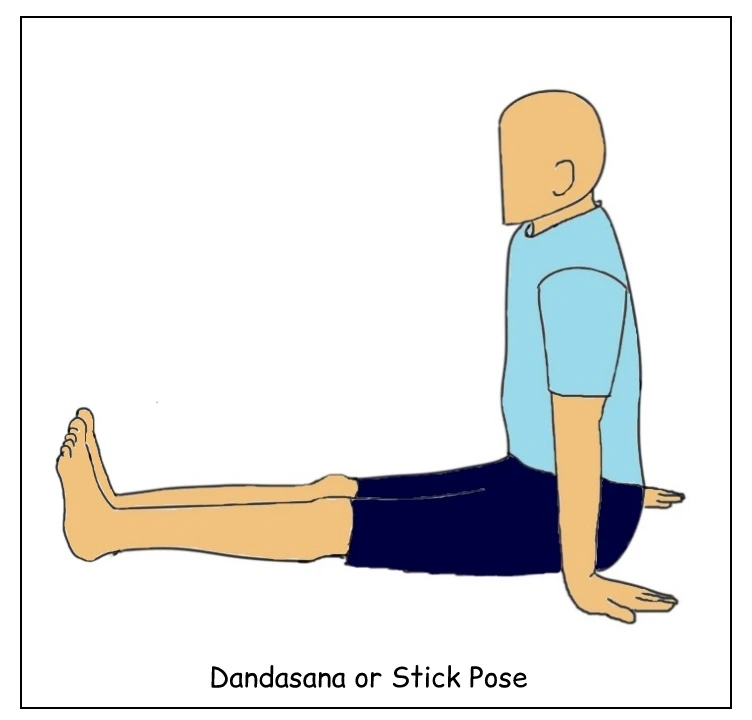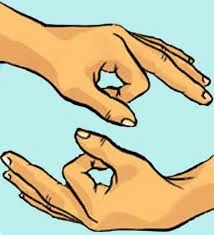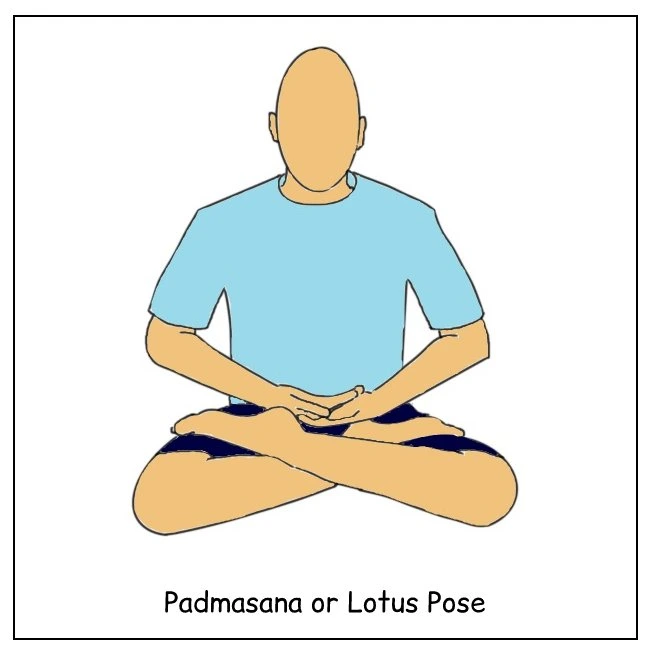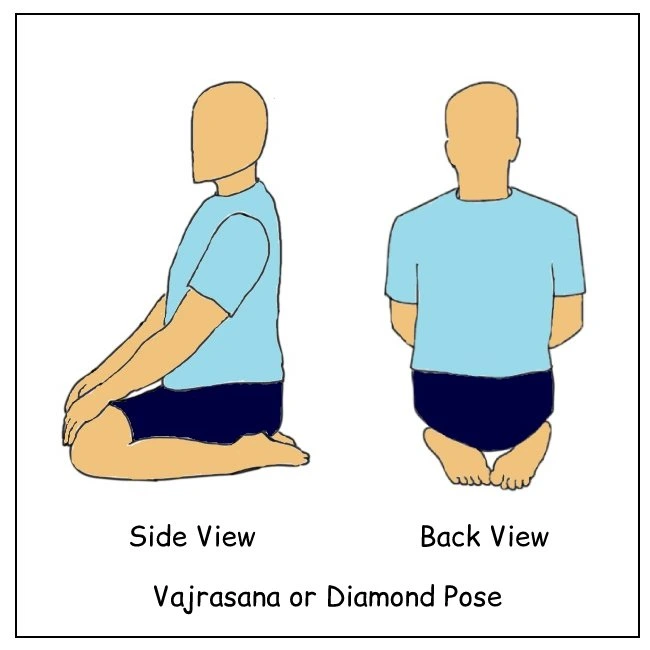What are the sitting yoga postures?
There are many asanas, or yoga postures, which are generally classified by the way the body is positioned. Each yoga posture is designed to stretch and improve specific muscles and joints. But here in this article, we will see only sitting yoga postures. Sitting yoga postures are the ones in which you can perform some asanas or kriyas and pranayama. You should use one of these postures when you are meditating. Apart from their use in performing other tasks, each of the postures alone has its benefits. Let’s see these yoga postures in detail:
1. Dandasana or Stick Pose:
Dandasana comprises of two words, Danda + Asana. ‘Danda‘ means stick and ‘asana‘ means posture. Hence this is called a Stick pose or Staff pose also.
Technique:
- Sit down on a yoga mat.
- Spread your legs to the front.
- Keep both legs straight and joined to each other.
- Place both palms facing downward on the mat beside your hips with fingers pointing to your backside.
- Keep your back and arms straight.

Benefits:
- Helps improve posture.
- Strengthens back muscles.
- Lengthens and stretches the spine.
- It May help to relieve complications related to the reproductive organs.
- Stretches shoulders and chest.
- Nourishes your body’s resistance to back and hip injuries.
- Helps to calm brain cells.
2. Padmasana or Lotus Pose:
Padmasana is a combination of two words, ‘Padma‘ meaning lotus and ‘asana‘ meaning pose. In this asana, the legs form the shape of a lotus flower hence it is called as Lotus pose.
Technique:
- Sit on a yoga mat in the Dandasana pose.
- While exhaling, place your right foot on your left thigh, then Inhale.
- Now again while exhaling, place your left foot on your right thigh.
- If you find the above sequence difficult, you can try with the left foot first.
- The soles of your feet should be above the heels, and heels should be below the belly button.
- Keep your back straight.
- Place your hands on your knees making Dnyanamudra (Touch the nails of the index fingers with your thumb keeping the remaining three fingers straight.)

- Or you can place your left hand near the lower abdomen just above the genitals and your right hand above the left hand as shown in the image.

Benefits:
- This is one of the best sitting yoga postures for Meditation.
- Helps in improving concentration and also helps in mental healing.
- Helps in improving digestion.
- Beneficial in Rheumatoid arthritis.
- Makes your skin glow.
- Helps you overcome the negative thoughts in your mind.
- Helps in insomnia disease.
- Beneficial in weight loss.
- Improve your memory and build confidence.
- This asana is also useful in Leprosy, paralysis, diseases caused by constipation, TB, Asthma, and Skin diseases.
3. Ardh–Padmasana or Half-Lotus Pose:
If you are finding it difficult to perform padmasana, you can start with Ardha-padmasana. ‘Ardha‘ in Sanskrit means half. Practicing Ardha–Padmasana can put you on the right track to perform padmasana.
Technique:
- Sit on a yoga mat in the Dandasana pose.
- While exhaling, place your right foot on your left thigh, then Inhale.
- Now again while exhaling, place your left foot under the right thigh.
- Keep your back straight.
- Place your hands on your knees making Dnyanamudra (Touch the nails of the index fingers with your thumb keeping the remaining three fingers straight.)
- Or you can place your left hand near the lower abdomen just above the genitals and your right hand above the left hand.
4. Vajrasana or Diamond Pose:
‘Vajra‘ can be defined as Thunderbolt or Diamond. Vajra is also a name for the Mythical weapon used by Lord Indra. It makes you strong like a weapon or a diamond, hence called vajrasana.
Technique:
- Sit relaxed on the yoga mat.
- Now fold your legs in such a way that your hips must rest on the feet.
- Make sure your heels are outwards a little bit on both sides.
- Both Big toes/Thumb toes should touch each other.
- Try to join both knees to each other and keep your back straight.
- Now rest your hands on your knees.

Benefits:
- This is the only sitting yoga posture that you can perform after having a meal. Performing Vajrasana after meals enhances digestive power.
- Helpful in all stomach-related diseases like gases, constipation, etc.
- Strengthens your knees and legs.
- Improves blood circulation throughout the body.
- Helps in semen transmutation which in turn strengthens your body.
5. Siddhasana or Accomplished Pose:
Siddhasana is a yogic posture that helps yogis to accomplish their spiritual journey. Therefore it is a favorite amongst yogis. It is also believed that this asana helps you to gain Ashta Siddhis (Eight Supernatural powers), hence it is named Siddhasana.
Technique:
- Sit in the Dandasana pose.
- Fold your left leg such that the heel touches between your anus and genitals.
- Now place the heel of the right foot above your genitals in such a way that it does not put weight on your genitals.
- The toes of both the feet should be between the thigh muscle and calf muscle of the opposite leg.
- Place your left palm near the lower abdomen on the right heel and right palm above the left with both the palms facing upward.
- Or Place your hands on your knees making Dnyanamudra (Touch the nails of the index fingers with your thumb keeping the remaining three fingers straight.)

- Keep your back straight.

Benefits:
- The practice of this asana helps in cleansing all 72000 Nadis (Energy Channels) in the body.
- Helps in improving mental wellbeing.
- It helps in increasing concentration and helps in making memory sharper. So it is a very useful posture for students.
- Also helpful in respiratory diseases, Heart disease, chronic fever, indigestion, etc.
- Stretches the front of your ankles.
- Strengthens calf muscles.
- Stretches your groin muscles, as a result, hip flexibility is improved.
- Stretches inner thighs/hip adductors.
- Strengthens your lower back.
6. Sukhasana or Easy Pose:
It is a go-to posture that we do even in our everyday life. Sukhasana comprises two words sukha (Comfort) and asana (Posture). The name itself implies that it is an easy-to-do posture. Older people or people with certain physical limitations can opt for sukhasana as it is the simplest posture.
Technique:
- Sit on the mat with your legs stretched out in front of you.
- Keep the spine straight.
- Take 2-3 deep breaths to calm your mind.
- Inhale and fold your legs.
- Place the hands on the thighs or on the knees with elbows bent.

Benefits:
- Easy to do posture.
- Relaxes the body and also calms the mind.
Conclusion:
There are a lot of yoga postures, breathing exercises, and other practices like meditation in yoga, where you need to sit down. As per the need of the asana and most importantly your comfort, you can choose any of the above postures. Sitting yoga postures can help to improve blood flow, lymph flow, and circulation. By sitting in certain postures for a certain amount of time, you can help to improve your overall health. When practicing sitting yoga postures, it is important to be aware of your posture and adjust as needed.
To read more about yoga, visit yogtastic.

Everything is very open with a really clear explanation of the issues. It was really informative. Your website is very useful. Many thanks for sharing!
Thanks for your blog, nice to read. Do not stop.
Thanks Mark!! 😀
Thank you for being of assistance to me. I really loved this article.
I love the practical applications you suggested.
I really appreciate the depth of information you’ve provided here. It’s clear that you’ve put a lot of thought and effort into this post.